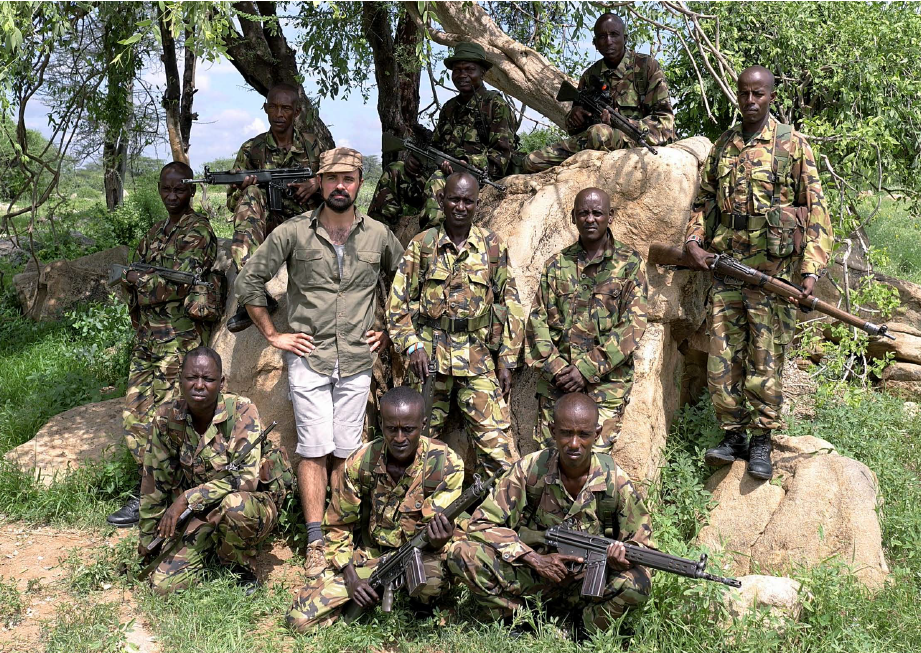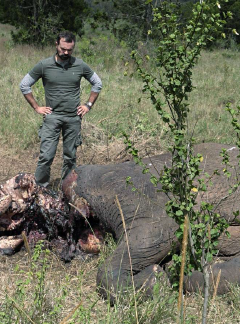Defence force: Kenya's poacher hunters
In the latest dispatch for our Christmas charity appeal, Evgeny Lebedev in Laikipia finds that gunfights with heavily armed enemies are a part of life for wildlife rangers


Your support helps us to tell the story
From reproductive rights to climate change to Big Tech, The Independent is on the ground when the story is developing. Whether it's investigating the financials of Elon Musk's pro-Trump PAC or producing our latest documentary, 'The A Word', which shines a light on the American women fighting for reproductive rights, we know how important it is to parse out the facts from the messaging.
At such a critical moment in US history, we need reporters on the ground. Your donation allows us to keep sending journalists to speak to both sides of the story.
The Independent is trusted by Americans across the entire political spectrum. And unlike many other quality news outlets, we choose not to lock Americans out of our reporting and analysis with paywalls. We believe quality journalism should be available to everyone, paid for by those who can afford it.
Your support makes all the difference.With an up-stretched hand the unit commander signals his patrol to stop. As one, the four men behind him sink to a crouch. Their weapons are raised as they scan the line of acacia trees in front of them.
The unit is dressed in combat fatigues. Their weapons are Heckler & Koch G3s, the German-made automatic rifle that is one of the most efficient and modern in the world, and their webbing filled with military supplies, including night-vision goggles and closed-frequency radios.
The medic, taking up the rear, has with him the latest combat kit, including bandages dripped in quick-clot – only just developed by US forces – to stop the bleeding from a gunshot wound.
To anyone who saw them, they would look like a military unit engaged in a war. Yet these men aren’t soldiers. They’re wildlife rangers. They are, however, at war – the increasingly bloody and ruthless war now being fought across Africa for ivory.
It is a conflict that sees patrols like this one on the Ol Pejeta conservancy in central Kenya risk their lives with increasing frequency. Before we had set out across the savannah for that day’s reconnaissance, I had been left in no doubt about the seriousness of the personal danger they routinely faced.
“A report came in on the radio that the poachers were active and we mobilised the helicopter to get to them before they could reach the animals,” Commander Jackson Kamunya told me as he described his most recent operation.
“It meant we got there ahead of them so we could set our ambush. We could see them, all armed with AK-47s. Then everyone started shooting.”
Twelve people have died recently in the poaching war being waged in just this small area. To the north in West Pokot county, five poachers were killed and two rangers wounded in a further fire-fight.
The same story is being repeated across the continent as the poaching crisis becomes ever more militarised. South Africa’s Kruger Park saw a police constable and a ranger killed as they tried to track poachers seeking rhino horn. Some 1,000 wildlife rangers – a third more than the entire losses of the British military in Iraq and Afghanistan – have been killed across Africa in the last decade in trying to save the continent’s great fauna.
It is heart-breaking to see first-hand the ones that the rangers could not save. While I was in Africa I was taken to an elephant carcass, the front of the skull cut off so that every ounce of ivory could be removed, and a rhinoceros too, now with its flesh stripped near bare by hyenas.
Nearby, three baby rhinos were having to be hand reared at a wildlife centre. Hope, just nine months old, had been orphaned after her mother was killed for her horn. Seeing me, she rushed up to nuzzle my leg. It was endearing and touching – and wonderful to know she is now protected 24 hours a day by the local conservancy staff.

The previous night I had been out with the men defending Lewa Conservancy, the wildlife haven adjacent to Ol Pejeta which is now Hope’s refuge. Yet again I found myself on the front line of a largely unknown and unreported war.
As night fell we headed north in a convoy of vehicles to take up our position on a nearby hill top. In the surrounding savannah, two-man teams of rangers were stealthily patrolling the ground, their senses acute for the first sign of trouble.
I was with the five-man rapid response team which acted as the central command point and was poised to swing in to action if contact was made. Like the patrol in Ol Pejeta they were heavily armed with the latest equipment. Like the men in Ol Pejeta they too had no illusion of the danger they faced.
“These poachers are not just people from the community,” their commander, Edward Ndiritu, told me in hushed tones as his men scanned the perimeter. “They’re criminal gangs that have a long history in areas such as drug trafficking. They’re organised and well-resourced.”
What is eye-opening is the range of resources now being utilised in this battle to give the good guys a fighting chance. It is not just the kit each man is issued. On Lewa, Mr Ndiritu explained, they already have a two-man dog unit and a helicopter. In the next few months trials will begin to use unmanned flying drones similar to those utilised by the American government in its hunt for al-Qa’ida to sweep the area.
Then there is the intelligence network which spreads throughout the surrounding towns and villages. This works in both an offensive and a defensive capacity. Their clandestine agents not only seek information on poaching plans but also seek to uncover the gang’s agents working within the conservancy itself.
With bribes of up to 500,000 Kenyan shillings (£3,500) regularly paid in a country where the annual average wage is a third of that, the risk of corruption among those protecting the wildlife is rife. Lewa has had to remove eight of its rangers for just this reason. It is perhaps appropriate that the man in charge at Lewa is a former military man himself. Mike Watson, ex-Green Jackets, is chief executive but his job has little to do with a comfortable desk. He now commands 150 men on the ground, 30 of them armed.
That doesn’t come cheap. “We are talking a million dollars a year just on security,” he tells me. But there is no alternative. So insidious has the crisis become that if they don’t ramp up their defences they would be out-gunned. Then there could be “no animals left”.
Police and the Kenya Wildlife Service have found poachers with everything from the Israeli Galil assault rifle to American M16s, although AK-47s remain their most popular weapon. The going rate for a gun in Kenya is around $100, a fraction of the amount that can be made from the ivory harvested from just one elephant.
This is why Space for Giants, the conservation charity that is the focus of The Independent’s Christmas campaign this year, has been so dedicated in ensuring the anti-poaching response can match the scale, and firepower, of the threat it faces. With its partners at Ol Pejeta and at Lewa, the charity has helped instigate training programmes, introduced a system of co-ordination across the region so intelligence is spread, and created mobile, helicopter-borne rapid response teams to quickly strike back, whether that is inside or outside the conservancies’ fences.
Dr Max Graham, the charity’s founder, insists there is no alternative. “The illegal trade has already effectively wiped out rhinos from the wild, forcing them to become a highly managed population in a small number of sanctuaries,” he says. “That is what will happen to elephants if the present rate of their slaughter – some 100 a day across Africa – continues.”
Back out on the patrol in Ol Pejeta, the unit is ready to move forward to its next observation point. Slowly they rise up and make their way through the bush, their footsteps silent as they cross the savannah.
Only a week before, two rhinos were killed nearby: the animals were shot dead and the horns dug out of them before their carcasses were left to rot. The previous night, intelligence came in that the poachers were gathering to strike, resulting in a mobilisation by the wildlife protection services across the area to stop them. Now reports are being heard of a disturbance to our east.
This is clearly a relentless campaign, and one with no likely end as long as the seemingly insatiable demand for ivory and other endangered animal parts in Asia continues. The mental strain for those at the sharp end must be momentous.
The ranger beside me, 28-year-old Paul Nyerito, admitted that for the first three months after he began patrolling he was plagued by “nightmares”, but nevertheless insisted this was a cause worth risking dying for.
“The animals are innocents,” he told me. “They’re not guilty. They don’t know they carry these precious things that place them at risk. If they did they would try to protect themselves. But they can’t. They’re innocent like children, and like children I must do what I can to protect them.”
Evgeny Lebedev is the owner of the Independent titles and London Evening Standard
Join our commenting forum
Join thought-provoking conversations, follow other Independent readers and see their replies
Comments